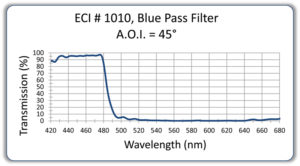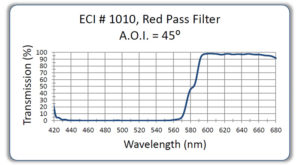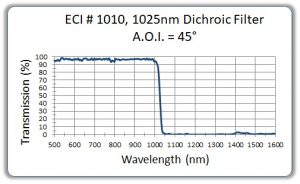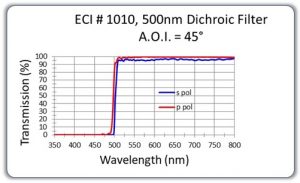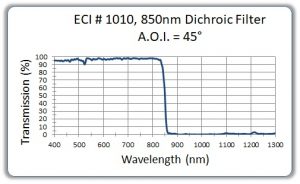These dichroic mirror films are deposited with high energy to insure stability with temperature and humidity changes. Contact our design team to discuss your specific dichroic mirror/dichroic filter requirements including: transmission wavelength range, steepness of cut on and cut off transitions, optical density, angle of incidence and incident medium.
High performance bandpass optical filter coatings are deposited on custom optics, semiconductors, crystals, polymers, fibers, and glass substrates up to 200mm in diameter.
Designs meet or exceed the environmental requirements of MIL-C-48497.
Contact our design team to discuss your specific dichroic mirror application!
ECI offers Dichroic Mirror coatings for high laser power applications
Use of high power laser sources in optical systems are increasing and ECI has developed new processes and fine-tuned existing processes that are suitable for use in the most demanding high power applications.
These dichroic mirror coating processes can be applied to a variety of different substrates, including windows, mirror blanks, lenses, semiconductor materials, laser crystals and fiber optic components. There are a number of things to consider when selecting the best process for a particular application.
What contributes to failure?
The primary cause of failure in high power applications is absorption sites. Areas where the laser energy is absorbed will lead to localized heating which can cause catastrophic failures. Absorption sites are going to be present when there is absorption in the coating materials used, a defect in the coating, or a defect on the surface of the substrate.
Therefore, coating materials with very low absorption are critical for high power applications. It is also imperative that the surface quality and cleanliness of the substrate be superb.
What does ECI consider when choosing which process to use?
When selecting the best process for a particular application, we need consider several factors. ECI will first examine the wavelength(s) required. Some materials ECI uses are absorbing at various regions, such a certain bands in the UV or IR spectrum. ECI would then examine the type of coating and any Laser Damage Threshold requirements.
Certain deposition methods are more suitable for certain types of coatings and exhibit a higher Laser Damage Threshold. ECI will also consider the substrate to be coated. Certain substrates have limitations regarding process temperature, which can limit which processes we can use.
What Laser Damage Threshold results can be expected?
ECI has had various coatings tested for Laser Damage Threshold with excellent results. Table 1 shows some LDT test results for pulsed lasers. Table 2 shows some LDT test results for continuous wave lasers.
Please note that individual results will vary based on the quality of the substrate, deposition method used, and coating materials used.
Table 1: Laser Damage Threshold test results for pulsed lasers
| Coating | Coating Type | Deposition Method | λ (nm) | AOI (°) | LDT (10ns pulse) |
|---|---|---|---|---|---|
| ECI #6468 | AR | IBS | 1064 | 0 | 22.5 J/cm2 |
| ECI #6468 | AR | E-Beam | 1064 | 0 | 63 J/cm2 |
| ECI #640 | HR | IBS | 1064 | 45 | 63 J/cm2 |
| ECI #640 | HR | E-Beam | 532 | 45 | 25 J/cm2 |
Table 2: Laser Damage Threshold test results for CW lasers
| Coating Type | Deposition Method | λ (nm) | AOI (°) | LDT (CW) |
|---|---|---|---|---|
| AR | IBS | 1064 | 0 | 2GW/cm2 |
| AR | E-Beam | 980 | 0 | >1.5MW/cm2* |
*Tested at maximum power with no damage. Future tests to be performed to determine typical results

